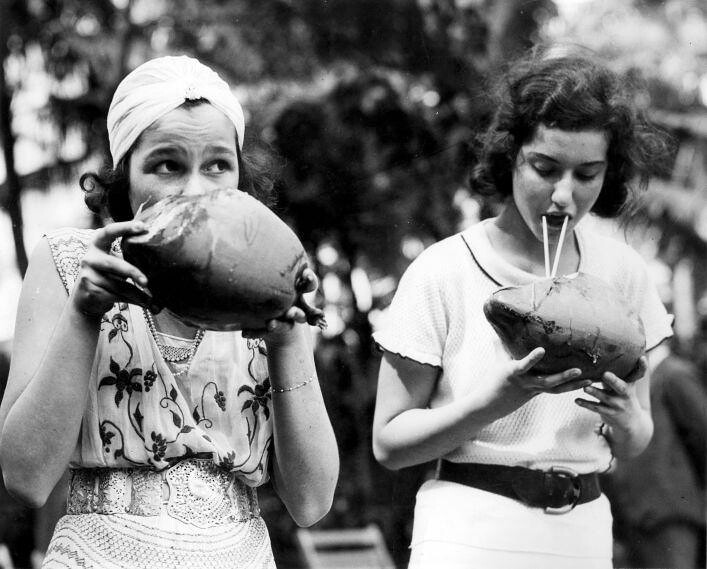Fast forward some 25 years later and what was only a vague inkblot of a memory (if you could even call it a memory) flashes before me as I taste my first fresh coconut in decades on the streets of south India. Not only do I discover that it is the perfect way to rehydrate after a very early morning yoga practice, it is also much cheaper than buying a bottle of water or one of those sugary sport drinks. Packed with naturally-occurring electrolytes - those little guys that help with rehydration - the water from the coconut is a godsend in hot and tropical climates like in India or the Philippines.
 |
| My day is just not complete without a coconut (Mysore, Karnataka, India) |
In India, I also discovered the benefits of using coconut oil externally, replacing my drug store moisturizer with a much cheaper bottle of coconut oil which I could also use to cook with. In fact, it is common in Indian culture to use coconut oil in the hair in place of conditioner. Bear in mind that there are processing differences between the hair oil and the cooking oil. I embarrassingly learned this through a local friend who came to visit my place when I was staying in Mysore, Karnataka in the south of India. He saw my blue bottle of coconut oil sitting on the kitchen shelf. He asked me if I used that oil for cooking. When I said yes, he was more than a little surprised and told me that Indians don't normally use that type of oil for cooking. Just for hair. What I learned that day was that not all coconut oils are created equal. For cooking, you want to look for an unrefined cold-pressed virgin oil, similar to when looking for a good olive oil, while a processed oil is fine for external use. I guess that explained why, at the local supermarket in Mysore, some of the coconut oil was in the hair care section and some was in the food section.
After having been spoiled with cheap and abundant access to coconuts in tropical locales like Bali and south India, I arrived on the Big Island of Hawaii. I knew that fresh coconuts were available but I also discovered that they are slightly pricier than in Asia (not a big surprise but admittedly a little disappointing). On the east side of the Big Island of Hawaii, for example, $2 is about the price of a coconut. Sometimes your neighbourhood coconut vendor will charge you extra to machete it open for you. Unless you are skilled in the art of machete, I advise you to pay the extra money or else risk the loss of appendages. In other parts of Hawaii, like Honolulu in Oahu, coconuts can cost as much as $10. I was told that coconuts are more of a cottage industry in the Hawaiian Islands, which came as a surprise to me considering there are so many coconut trees. They just don't spend time cultivating and farming them. It still worth the cost though, considering we often spend upwards of $4 on specialty coffees and other beverages and I would consider the coconut something very special.
 |
| Boy, this coconut sure if refreshing (photo courtesy of Nationaal Archief) |
Do-It-Yourself
If you are feeling a little daring, are physical fit, and happen to have access to a machete, then you might feel compelled to climb a coconut palm and get a coconut all on your own - renegade style. Many coconut trees grow wild and you'll often see people in India and even Hawaii climbing coconut palms to get their hands on the goods themselves. There is definitely an art to coconut harvesting. The tree climbing is the first part, then there's the hacking off of the coconut, and finally coming down. For me personally, it's the getting down that would be my biggest challenge. The coconut palm can grow up to 30 m (98 ft). That's a mighty long way down!Beware of falling coconuts!
For those who yearn to find themselves sitting under a shady coconut tree on an idyllic tropical beach, beware! What may seem innocent and serene could prove fatal. Many die each year from falling coconuts. As the coconuts mature they can become loose from the tree. Imagine you're sitting under a 30 m tall coconut palm. The coconuts sit high up near the top of the tree right under the palm leaves. Now imagine the impact of one of these heavy coconuts disengaging from the tree and falling to the ground - or worse, someone's head. It's very common to see signs cautioning passersby and leisure-seekers of falling coconuts. My rule of thumb when choosing a shady spot on a beach, whether I'm in Bali, Indonesia or far north Queensland in Australia, is to first look up. Coconut trees can provide great shade but at what cost. Just make sure that the tree is empty of fruit first. |
| Coconut palm on the Big Island of Hawaii |
 |
| The coconut does not fall far from the tree, but it does fall far to the ground |
 |
| One coconut for every day of the week |
For those who have never had the pleasure of drinking the fresh water straight from a newly macheted coconut, here are a few tips:
- When asking for your coconut, be sure to tell the coconut vendor what type of coconut you want. A young coconut yields water but no hard coconut meat although you might get a little jelly. An older coconut will give you a sweeter water and lots of delicious white coconut meat. Sometimes the water from the older coconut can be a little fermented and bubbly like champagne but it should still be ok to drink. In fact, some people like it this way.
- After you've finished drinking the water, ask the coconut vendor to hack it in half for you if there is any meat inside. The vendor will probably also cut off a little piece of the husk to use as a scoop. Coconut water and meat can be very filling. In fact, if I have a coconut with a lot of meat, I'll ask the coconut vendor to cut it in half for me so that I can take both halves home with me and have the meat later.




FOR THE LOVE OF COCONUTS, Its very interesting because speak of the fruit and the properties and benefits of this, In South America we have many fruits and plants that have properties and benefits such as coca, noni ....
ReplyDeleteYes I know! I've spent a lot of time in South America over the last couple of years - mainly Peru, Bolivia and Argentina. Many of the world's "superfoods" come from this part of the world. Acai, lucuma, maca, sacha inchi, and cacao are my personal favourites and I miss the easy access to the real thing.
DeleteHi, Great blog! I'm currently doing some outreach at Preply and I thought your blog would be perfect to team up on. Preply is a language learning platform online where people could learning languages. We connect students and teachers via Skype. If you are interested just email me back. Thanks again!
ReplyDeletehttps://www.preply.com